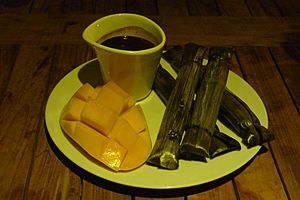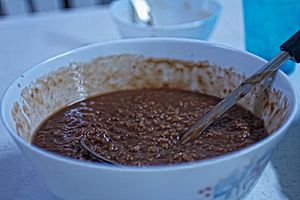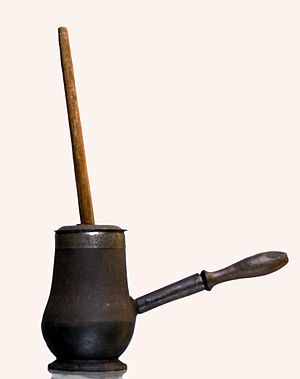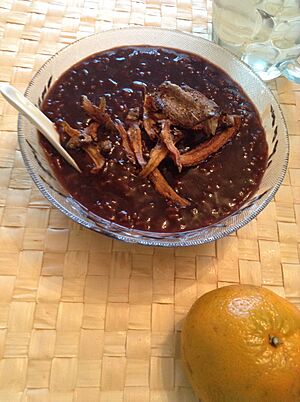Chocolate industry in the Philippines facts for kids
The chocolate industry in the Philippines grew a lot after the cocoa tree was brought to the country. Growing cacao or cocoa has a long history, going back to the Spanish colonial times. Cacao first came from forests in Mesoamerica. The Spanish colonizers brought it over four centuries ago. Since then, the Philippines has been a main producer of cocoa beans in Southeast Asia. Many places in the Philippines grow cacao because of the good soil and climate. The chocolate industry there is currently small to medium-sized.
Contents
The Story of Chocolate in the Philippines
What's in a Name?
The word "chocolate" has been spelled many ways over time. These include "chocalatall," "jocolatte," and "chockelet." It comes from the Aztec words cacahuatl or xocoatl. These words described a bitter drink the Aztecs made from cacao beans. They mixed it with spices, wine, and other local ingredients in ancient Mexico.
Cacahuatl combines Mayan words kaj and kab. This means “bitter juice.” The word -atl, meaning water or liquid, was added to kajkab. This formed kajkabatl, and later kajkabhuatl.
The cacao tree's scientific name is Theobroma cacao. Carolus Linnaeus, a Swedish botanist, gave it this name in 1753. Theobroma means “food for the Gods.” This comes from the Greek words theo (god) and broma (food). Cacao beans are mainly used to make chocolate and cocoa.
In the Filipino language, chocolate is called tsokolate. This is also a hot chocolate drink. It is made from tablea, which are cacao tablets. These tablets are made from roasted and ground cacao nibs. Filipinos traditionally use them for hot chocolate. A batirol, like the Mexican molinillo, is used to mix hot water with the tablet. This makes it frothy. The result is tsokolate de batirol, a thick, creamy hot chocolate. In the Visayas region, it is called sikawate.
Tablea is also used to make champorado. This is a sweet rice porridge dish in the Philippines. Many people enjoy it hot or cold. It is often eaten with dried fish, called tuyo or daing.
Cacao's Journey to the Philippines
The cacao plant first arrived in the Philippines in the 1700s. A Spanish galleon from Mexico brought pure Criollo cacao. This type is thought to be one of the best kinds. It traveled from Mesoamerica across the Pacific. Cacao trees originally grew in Mexico and Central America. But the Philippines became a great place to grow cacao. This is because it is a tropical rainforest. It is located 10-15 degrees from the Earth's Equator. The "cacao belt" is within 20 degrees of the Equator. Today, cacao trees grow in many equatorial regions. These include the Caribbean, Africa, Southeast Asia, and Pacific Islands like Samoa and New Guinea.
Top Cacao Growing Areas
Batangas Even though Batangas only produced a small amount of cacao in 2016, it is famous for its tsokolate tablea. These chocolate tablets are a special treat. They are often used to make traditional Filipino hot chocolate.
Cebu Cebu and other Central Visayas provinces produce only about 1% of the country's cacao. However, Cebu is known for growing high-quality cacao. There are fewer than a hundred farmer groups and growers in Cebu. They plant cacao on about 2,000 hectares. But the province wants to grow much more cacao. Cebu is home to criollo or “cacao bisaya.” This is a top-quality cacao with a strong, bittersweet taste and rich texture. Cebu also has famous chocolate makers like Ralfe Gourmet and The Chocolate Chamber.
Davao Region The Davao region produces 81% of the Philippines' annual cacao. This is according to the Philippines Statistic Authority. Davao del Sur, Davao City, Davao del Norte, Davao Oriental, and Compostela Valley were the top producers in 2016. The region has over 20,000 hectares of cacao farms. Davao City has the largest area, with 6,060 hectares. This region is also home to a well-known cacao business, Malagos chocolate.
Groups Helping the Chocolate Industry
Department of Agriculture (DA) The Department of Agriculture (DA) is a government agency. It helps farming in the Philippines grow. It provides rules, money, and support for farmers. The DA gives technical and financial help to cacao farmers. This is because cacao is a "high-value crop."
Department of Trade and Industry (DTI) The Department of Trade and Industry (DTI) is another government department. It works to make the country's industries strong and creative. This helps create jobs and growth for everyone. They have made plans and rules to support the cacao industry.
DOST-PCAARRD The Department of Science and Technology - Philippine Council for Agriculture, Aquatic, and Natural Resources Research and Development (DOST-PCAARRD) is a top group for research and development (R&D). They focus on farming, water, and natural resources in the Philippines. They create plans and programs for science and technology in these areas. They also manage R&D money and check on projects. DOST-PCAARRD has made special plans for cacao. These plans include all the science and technology efforts to help the industry grow.
CocoaPhil The Cocoa Foundation of the Philippines (CocoaPhil) is a non-profit group. It represents the local cocoa industry. Their goal is to plant more hectares of cocoa. They want to reach the goals of the Philippines Cacao Roadmap. This roadmap was made by the Department of Agriculture and the Department of Trade and Industry. CocoaPhil aims to turn at least 100,000 hectares into cacao farms. They want to grow cacao under coconut trees.
CIDAMi The Cacao Industry Development Association of Mindanao Inc. (CIDAMi) is an active group in the cacao business. Its members include farmers and academics. Their goal is for Mindanao to produce world-quality cacao. CIDAMi has many projects, services, and training programs. They work with other groups to achieve their vision. Examples are CaCao Feast and Cacao Doctors Training.
FedCo The Federation of Cooperatives in Mindanao (FedCo) is a cooperative based in Mindanao. Its goal is to improve the lives of its members. They do this by exporting high-quality farm products like cacao and bananas. They help small farmers by connecting them directly to international buyers.
CACAO The Center for Advanced Community Agriculture Operations (CACAO) is a group of farming fans. They want to solve problems in farming production and sales. They plan programs to help small farmers earn a living. They also aim to produce enough, or even more, supply for the market.
The Chocolate Business in the Philippines
How the Industry Works
Cacao comes from forests in South America. It is the main ingredient for chocolate. Today, most cacao comes from African and European countries. These include the Ivory Coast, Germany, and Belgium. The Philippines is a smaller player in the global chocolate world. But it grows cacao almost everywhere in the archipelago, even in the early 1900s.
Cacao Industry Details
The Philippine cacao industry mostly has smallholder farmers. They supply cacao to medium-sized chocolate makers. However, the country doesn't produce enough cacao. The local demand for cacao is higher than the supply. One big reason for this is that farmers lack knowledge and tools. They need better ways to prepare cacao beans after harvest. This would ensure good quality for making chocolate. Because of this, the Philippines exports much less cacao than it imports. In 2012, the Department of Trade and Industry reported that cacao imports were 3,662 tons. But cacao exports were only 512 tons.
Imports of Cocoa and Cocoa Preparations (million kg.)
| 2009 | 2010 | 2011 | 2012 | 2013 | |
|---|---|---|---|---|---|
| Cocoa beans, whole or broken, raw or roasted | 123 | 738 | 307 | 150 | 223 |
| Cocoa shells, husks, skins and waste | 2,151 | 2,032 | 1,753 | 1,969 | 2,633 |
| Cocoa paste | 6,080 | 5,434 | 4,522 | 640 | 579 |
| Cocoa powder, unsweetened | 13,284 | 15,024 | 13,872 | 11,120 | 13,340 |
| Chocolate and other foods containing cocoa | 11,645 | 12,453 | 12,711 | 13,939 | 16,655 |
Exports of Cocoa and Cocoa Preparations (million kg.)
| 2009 | 2010 | 2011 | 2012 | 2013 | |
|---|---|---|---|---|---|
| Cocoa beans, whole or broken, raw or roasted | 299 | 196 | 127 | 440 | 554 |
| Cocoa shells, husks, skins and waste | 20 | - | - | - | - |
| Cocoa paste | 121 | 41 | 265 | 245 | 138 |
| Cocoa powder, unsweetened | 313 | 663 | 812 | 21 | 15 |
| Chocolate and other foods containing cocoa | 784 | 863 | 786 | 1,028 | 3,002 |
Growing Demand for Tablea
More cafes and restaurants are now offering chocolate drinks. This has led to a rise in demand for tablea. Also, more people are choosing healthy lifestyles. This has slowly increased the demand for tablea too. This is good news for cacao farmers and chocolate makers. It means they might earn more money.
Who Makes Chocolate in the Philippines?
Philippine Market
The chocolate market in the Philippines has both local and international companies. The three biggest companies that process cocoa are Universal Robina, Commonwealth Foods, and Goya. All of them are in Metro Manila. Other well-known brands also sell chocolate in the country. These include Nestlé, Hershey's, and Cadbury Adams.
Local and Foreign Cocoa-processing Companies
| Local | Foreign |
|---|---|
| Multirich Foods Corporation | Nestlé Philippines Inc. |
| Columbia International Food Products Inc. | Hershey's Philippines Inc. |
| Monde Nissin | Cadbury Adams (Philippines) Inc. |
| Twin Oaks Foods Corporation | Mars Philippines Inc. |
| Stateline Snack Food Corporation | Gandour Philippines Inc. |
| New Unity Sweets Manufacturing | Delfi Marketing Inc. |
| Annie Candy Manufacturing (Annie's) | Rustan's Marketing Specialists, Inc. |
| Gracepoint Enterprises (Lala) |
Other Local Brands
Mama Earth Cacao
Mama Earth Cacao makes chocolate from bean to bar. They have their own farms in Monkayo and make products in Samal Island. They create high-quality tableas, chocolate, nibs, and cacao powder.
CACAO Davao
CACAO Davao, from Calinan Cacao Products, sells raw cacao items. These include cacao beans, cacao nibs, and cacao liquor. CACAO stands for Center for Advanced Community Agriculture Operations. Their processing is done in Calinan, Davao City. CACAO Davao works closely with local processors and producers.
Theo & Philo
Philo Chua started Theo & Philo in 2010. It was the first company in the Philippines to make single-origin chocolate from bean to bar. Theo & Philo chocolates go through six steps to become high quality. Their flavors include Dark Chocolate with Calamansi, Milk Chocolate Adobo, and Dark Chocolate Siling Labuyo. They also have Milk Chocolate with Barako Coffee and Dark Chocolate with Green Mango and Sea Salt.
Malagos
Malagos Chocolate is a single-origin chocolate maker from Davao. The name Malagos means “strong flow of water.” The Malagos farm is at the foot of Mt. Talomo. It is said to be near the equator, where cacao grows best. All the steps, from planting to making the chocolate, happen on this farm.
Fabros Farm
The Fabros Farm covers about 50 hectares. They have planted 30,000 tree seedlings. It has two locations: Agtedtedted, the first farm, and Mumunsi, in Aurora. Cacao grows naturally in Maria Aurora. Cacao trees are even grown in people's backyards there. Mumunsi Chocolate Café is named after the mountain where cacao trees are planted.
Ralfe Gourmet
Raquel Choa learned how to plant cacao from her grandmother. She became a tablea maker. She is also the founder and president of Ralfe Gourmet. Ralfe Gourmet makes tablea that is 100% cacao. To make their cacao, the beans are roasted, fermented, and solar-dried.
Local Chocolate Makers
Universal Robina Corp.
Universal Robina Corporation (URC) is one of the biggest food and drink makers in the Philippines. They are known for their instant coffee mix, popular with Filipinos. They also own the Jack ‘n Jill brand. This brand makes 26 snack products. URC uses a lot of chocolate. Most of their bakery and candy snacks have chocolate in them. URC's first big chocolate product was Nips. These were candy-coated chocolates, like M&M's, and kids loved them. After that, they made many other chocolate products. These include Wiggles (chocolate-covered marshmallows) and Cloud 9 (a chocolate-covered nougat bar).
Commonwealth Food Inc.
Commonwealth Food Incorporated (ComFoods) is a Philippine company that makes many products. These include coffee, chocolate, and biscuits. Their chocolate making is handled by the Philippine Food Industries Incorporated branch, also called Philfood. They make natural cocoa powder. They also produce chocolate syrup, Kool Joy (mint-candy covered chocolate), Flat tops (chocolate candy), and Cocoa Butter. They sell cocoa butter to customers in the United States and Europe. ComFoods also has a biscuit division. The Fibisco Biscuit Corporation makes Filipino favorites like Choco Mallows, Hi-ro, and Chocolate Chip cookies.
The Future of Philippine Chocolate
The amount of cocoa available has changed in recent years. This is due to weather and money problems. The El Niño weather event in 2009 greatly reduced cocoa production. Bad weather and money troubles limited both the supply and demand for cocoa. Even though demand for cocoa is rising, the supply is still going down. Many business people and governments are now looking into cocoa production. They want to compete with Africa, the top producer. Africa produces over 70% of the world's cocoa. On the other hand, the Netherlands and the United States are the biggest buyers of cocoa beans. They buy billions of U.S. Dollars worth of cocoa.
According to the United Nations, the Philippines has changed. It used to buy a lot of cocoa beans. Now, it is a steady exporter of the bean. Business people saw the potential in the cocoa bean industry. They noticed the rising demand and falling supply. This gave them the idea to plant many hectares of cacao. The Philippine government also encourages people to grow cocoa beans because of the shortage. They help farmers and the industry by providing land and proven methods. This is to increase the Philippines' cocoa bean production. The Philippines has the right climate and soil for the cocoa tree. The government's challenge is to share knowledge on how to plant and harvest cocoa. They are working hard to compete with other cocoa producers. The Philippine government is getting ready for a cocoa shortage by 2020. They aim to produce 100,000 Metric Tons. The Philippines is not yet meeting its local demand of 30,000 Metric Tons. But strong efforts and government support are sure to make a difference in the coming years.
How Cocoa is Made in the Philippines
Cacao or cocoa beans are grown in many places in the Philippines. These include Luzon, Mindanao, Joló, Basilan, Panay, Negros, Cebú, Bohol, and Masbate. Cocoa also refers to cocoa powder and cocoa butter. These are two products made from the cacao bean after it is processed. Commonwealth Foods Inc. (ComFoods) first started cocoa and chocolate processing in the Philippines in 1953. Serg's Chocolate Products Inc. became the first modern chocolate factory in Southeast Asia.
The Process of Making Cacao
Planting and Farming
To plant cacao in the Philippines, there are 9 approved varieties. These are chosen for high production, good bean quality, and resistance to pests. The Soil needs to be deep and drain well. But it also needs to hold enough water. Clay loam soil works best. It has sand, silt, and clay. This mix helps with aeration, drainage, and keeping moisture. Organic matter on the soil surface is also important. The soil must be well-shaded to protect this organic layer. Ideal rainfall is between 1,250 and 3,000 mm per year. The dry season should not be longer than 3 months. The temperature should be from 18 to 32 degrees Celsius. This temperature is found in areas up to 700 meters high. Cacao likes a moist atmosphere. So, even rainfall and few winds are best.
Seeds are chosen carefully from healthy, high-producing trees. They are planted right away. This can be in seed beds, pots, or nurseries. Then they are moved to plantations. If the soil is forest land with good organic matter, you don't need to till it. But if cacao is planted with other crops, more work is needed. This includes plowing and harrowing the land. Roads, drainage, and shade trees are also set up. Cacao is usually planted in rows 2 meters apart in open areas. Under coconut trees, they are 2.5 meters from the base. They can also be planted close together and then thinned out. Or they can be 3 by 3 meters or 3 by 4 meters apart.
Growing trees from seeds is still done. But now, grafted or budded cacao seedlings are also used.
Pruning
Pruning means carefully cutting branches. This is usually done with a sharp saw during the dry season. It happens when new branches have grown or after harvest. This helps control the tree's height. It also makes harvesting and care easier. The first pruning is done to control where the first branch forms. This is usually at least 5 feet high. This helps with harvesting and maintenance. When five or more branches have grown, weak ones are cut. Only three or four strong branches are left. The cut surfaces are then painted. This protects them from diseases or pests.
Nutrition and Fertilizers
The health of cacao trees is checked by testing the soil and leaves. If there are not enough minerals, fertilizers are added. Fertilizers are put on cacao trees about two to three months after planting. The amount is increased in the second, third, and fourth year. Fertilizers used on Cacao include Ammonium sulfate, Single superphosphate, Potassium sulfate, and Magnesium sulfate.
Harvesting
Cacao pods are harvested when they are ripe or mature. Cacao usually ripens during the dry season. You can tell they are ripe by the chocolate smell in the farm. Or by the pod color changing to reddish or yellow. The pods are cut with a sharp knife. They are cut as close to the stem as possible. This is done very carefully. It's important not to harm the flower cushions, pods, or the tree. Infected pods are removed. Farmers usually harvest about four times per season. These harvests are 10 to 21 days apart.
Sorting and Grading
Sorting and grading make the beans better quality. Once the beans are fully dried, they are sorted. This removes flat, slaty, black, moldy, small, or double beans. It also removes beans with insect damage. Beans are usually graded based on how many defective beans they have. This follows the Philippine National Standards for Cacao or Cocoa Beans. These steps ensure quality before the beans are shipped or handled.
Packaging and Storage
The dried cocoa beans are packed in bags. These bags are made of food-grade or non-toxic materials. Examples are jute bags or sacks. They have a label, production number, date, bean grade, and cooperative code. They are stored in places that are weatherproof and well-ventilated. They must be free from moisture, insects, or anything else that could contaminate the cacao.
What Cacao Becomes
After the beans are shipped to different manufacturers, they are used for many things. They become cocoa powder, cocoa butter, and tablea (cocoa liquor). They also become other chocolate products like liquid chocolate and chocolate bars. Tablea and cocoa powder are used to make many treats. These include hot chocolate, champorado, tablea de cacao cupcakes, tablea brownies, and crinkles.
For chocolate bar flavors, Filipino chocolate brands offer unique tastes. These include chili, mango, calamansi, barako coffee, adobo, pili nuts, pastillas, bacon, turon, and coconut.






